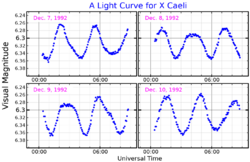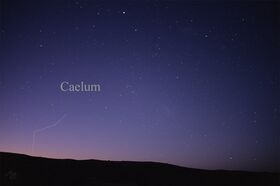Astronomy:X Caeli
| Observation data Equinox J2000.0]] (ICRS) | |
|---|---|
| Constellation | Caelum |
| Right ascension | 05h 04m 26.19316s[1] |
| Declination | −35° 42′ 17.7574″[1] |
| Apparent magnitude (V) | 6.28 – 6.39[2] (6.43 + 9.65)[3] |
| Characteristics | |
| Spectral type | F2 IV/V[4] |
| B−V color index | 0.311±0.006[5] |
| Variable type | δ Sct[6] |
| Astrometry | |
| Radial velocity (Rv) | +6.4±0.8[7] km/s |
| Proper motion (μ) | RA: +28.39[8] mas/yr Dec.: +41.71[8] mas/yr |
| Parallax (π) | 9.5567 ± 0.0583[1] mas |
| Distance | 341 ± 2 ly (104.6 ± 0.6 pc) |
| Absolute magnitude (MV) | 1.36[5] |
| Details | |
| Mass | 1.52[9] M☉ |
| Radius | 3.43±0.32[10] R☉ |
| Luminosity | 23.65[5] L☉ |
| Surface gravity (log g) | 3.80[9] cgs |
| Temperature | 7,227±246[9] K |
| Rotational velocity (v sin i) | 69.0±1.0[10] km/s |
| Age | 961[9] Myr |
| Other designations | |
| Database references | |
| SIMBAD | data |
X Caeli, or Gamma2 Caeli, is a binary star system in the southern constellation of Caelum. It is barely visible to the naked eye with an apparent visual magnitude of 6.32.[5] based upon an annual parallax shift of 9.6 mas,[1] it is located 341 light-years from Earth. The system is moving further away with a heliocentric radial velocity of +6 km/s.[7]

The yellow-white-hued primary, component A, has an apparent magnitude of +6.32 and stellar classification of F2 IV/V,[4] showing mixed traits of an F-type main-sequence star and a subgiant. It is classified as a Delta Scuti-type variable star and its brightness varies from magnitude +6.28 to +6.39 with a period of 3.25 hours. A 2000 observing campaign identified at least six independent pulsation modes for this variation.[10] The companion star, component B, has an apparent magnitude of +9.65 and, as of 2000, is at an angular separation of 0.890″ along a position angle of 183°.[3]
References
- ↑ 1.0 1.1 1.2 1.3 Brown, A. G. A. (August 2018). "Gaia Data Release 2: Summary of the contents and survey properties". Astronomy & Astrophysics 616: A1. doi:10.1051/0004-6361/201833051. Bibcode: 2018A&A...616A...1G.
- ↑ VSX:Detail for X Cae, https://www.aavso.org/vsx/index.php?view=detail.top&oid=4518, retrieved 2018-08-24.
- ↑ 3.0 3.1 Fabricius, C.; Makarov, V. V. (April 2000), "Two-colour photometry for 9473 components of close Hipparcos double and multiple stars", Astronomy and Astrophysics 356: 141–145, Bibcode: 2000A&A...356..141F.
- ↑ 4.0 4.1 Houk, Nancy (1979), Michigan catalogue of two-dimensional spectral types for the HD stars, 3, Ann Arbor, Michigan: Dept. of Astronomy, University of Michigan, Bibcode: 1982mcts.book.....H.
- ↑ 5.0 5.1 5.2 5.3 Anderson, E.; Francis, Ch. (2012), "XHIP: An extended hipparcos compilation", Astronomy Letters 38 (5): 331, doi:10.1134/S1063773712050015, Bibcode: 2012AstL...38..331A.
- ↑ Samus', N. N; Kazarovets, E. V; Durlevich, O. V; Kireeva, N. N; Pastukhova, E. N (2017), "General catalogue of variable stars: Version GCVS 5.1", Astronomy Reports 61 (1): 80–88, doi:10.1134/S1063772917010085, Bibcode: 2017ARep...61...80S.
- ↑ 7.0 7.1 Gontcharov, G. A. (November 2006), "Pulkovo Compilation of Radial Velocities for 35495 Hipparcos stars in a common system", Astronomy Letters 32 (11): 759–771, doi:10.1134/S1063773706110065, Bibcode: 2006AstL...32..759G.
- ↑ 8.0 8.1 van Leeuwen, F. (November 2007), "Validation of the new Hipparcos reduction", Astronomy and Astrophysics 474 (2): 653–664, doi:10.1051/0004-6361:20078357, Bibcode: 2007A&A...474..653V.
- ↑ 9.0 9.1 9.2 9.3 David, Trevor J.; Hillenbrand, Lynne A. (2015), "The Ages of Early-type Stars: Strömgren Photometric Methods Calibrated, Validated, Tested, and Applied to Hosts and Prospective Hosts of Directly Imaged Exoplanets", The Astrophysical Journal 804 (2): 146, doi:10.1088/0004-637X/804/2/146, Bibcode: 2015ApJ...804..146D.
- ↑ 10.0 10.1 10.2 Mantegazza, L. et al. (February 2000), "Simultaneous intensive photometry and high resolution spectroscopy of delta Scuti stars. IV. An improved picture of the pulsational behaviour of X Caeli", Astronomy and Astrophysics 354: 112–124, Bibcode: 2000A&A...354..112M.
- ↑ "HD 32846". SIMBAD. Centre de données astronomiques de Strasbourg. http://simbad.u-strasbg.fr/simbad/sim-basic?Ident=HD+32846.
- ↑ Mantegazza, L.; Poretti, E. (August 1996), "Simultaneous intensive photometry and high resolution spectroscopy of δ Scuti stars. II. X Caeli: a star with unusual spectral features", Astronomy & Astrophysics 312: 855–864, Bibcode: 1996A&A...312..855M.
External links
 |


